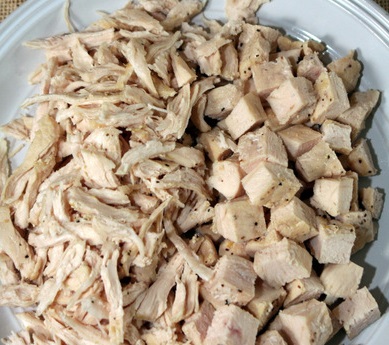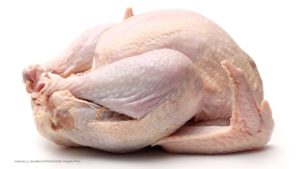The Canadian food inspection Agency (CFIA) issued an update after expanding Listeria monocytogenes outbreak related to the U.S. company Tip Top Poultry. CFIA has issued a recall (August 18) to Rosemount brand cooked diced chicken. Now another recall, this one for Reuven International Ltd. brand Natural Proportion Cooked Chicken Meat (Diced) and Sysco brand Natural Proportions Cooked Shredded Chicken was issued. The additional products were identified during the CFIA’s food safety investigation of an outbreak that was initiated due to an increase of Listeria illnesses that were reported in June 2019. The recalled products were distributed nationally to hotels, restaurants, hospitals, nursing homes and retail outlets, the CFIA said. The products have been sold in British Columbia, Alberta, Saskatchewan, Manitoba, Ontario, Quebec, Newfoundland and Labrador and may have been distributed to other provinces and territories. Both the Reuven and Sysco products are in the 4.54-kilogram package with pack dates of Jan. 21, 2019. @ https://www.inspection.gc.ca/about-the-cfia/newsroom/food-recall-warnings/complete-listing/2019-08-21/eng/1566441064966/1566441070819
ruth
The food recall warning issued on August, 18, 2019 has been updated to include additional product information.
Doug-B
In the September 2019 issue of Applied and Environmental Microbiology, an article was published on a study investigating the microbial dynamics in multispecies biofilms of Escherichia coli O157:H7 strain 1934 (O157) or Salmonella enterica serovar Typhimurium ATCC 14028 (ST) and 40 strains of meat processing surface bacteria (MPB). Biofilms of O157 or ST with/without MPB were developed on stainless steel coupons at 15°C for up to 6 days. In suspensions, levels of O157 and ST were ∼2 log higher in single-species than in multispecies cultures on both sampling days. ST was 3 log higher in single-species than in multispecies biofilms. A similar trend, though to a lesser extent, was observed for O157 in biofilms on day 2 but not on day 6. No difference (P > 0.05) in bacterial counts was noted for the two MPB-pathogen co-cultures at any time during incubation. Results of this study demonstrate that Salmonella enterica serovar Typhimurium and E. coli O157:H7 can integrate into biofilms when co-cultured with bacteria from meat plant processing surfaces. However, the degree of biofilm formation for both pathogens was substantially reduced in the presence of the competing microbiota, with S. Typhimurium more greatly affected than E. coli O157:H7. The expression of extracellular determinants such as curli and cellulose appears to be less important for biofilm formation of the pathogens in multispecies cultures than in monoculture. In contrast to previous reports regarding food processing surface bacteria, data collected here also demonstrate that facultative anaerobes may have a competitive edge over strict aerobes in establishing multispecies biofilms. @ https://aem.asm.org/content/85/17/e01123-19
This study investigated the microbial dynamics in multispecies biofilms of Escherichia coli O157:H7 strain 1934 (O157) or Salmonella enterica serovar Typhimurium ATCC 14028 (ST) and 40 strains of meat processing surface bacteria (MPB). Biofilms of O157 or ST with/without MPB were developed on stainless steel coupons at 15°C for up to 6 days. Bacteria in suspensions (inoculum, days 2 and 6) and biofilms (days 2 and 6) were enumerated by plating. The composition of multispecies cultures was determined by 16S rRNA gene sequencing. In suspensions, levels of O157 and ST were ∼2 log higher in single-species than in multispecies cultures on both sampling days. ST was 3 log higher in single-species than in multispecies biofilms. A similar trend, though to a lesser extent, was observed for O157 in biofilms on day 2 but not on day 6. No difference ( P > 0.05) in bacterial counts was noted for the two MPB-pathogen cocultures at any time during incubation. Bacterial diversity in multispecies cultures decreased with incubation time, irrespective of the pathogen or culture type. The changes in the relative abundance of MPB were similar for the two MPB-pathogen cocultures, though different interbacterial interactions were noted. Respective fractions of ST and O157 were 2.1% and 0.97% initially and then 0.10% and 0.07% on day 2, and 0.60% and 0.04% on day 6. The relative proportions of facultative anaerobes in both multispecies cultures were greater in both suspensions and biofilms than in the inoculum. Citrobacter , Hafnia , Aeromonas , and Carnobacterium predominated in biofilms but not always in the planktonic cultures.
IMPORTANCE Results of this study demonstrate that Salmonella enterica serovar Typhimurium and E. coli O157:H7 can integrate into biofilms when cocultured with bacteria from meat plant processing surfaces. However, the degree of biofilm formation for both pathogens was substantially reduced in the presence of the competing microbiota, with S. Typhimurium more greatly affected than E. coli O157:H7. The expression of extracellular determinants such as curli and cellulose appears to be less important for biofilm formation of the pathogens in multispecies cultures than in monoculture. In contrast to previous reports regarding food processing surface bacteria, data collected here also demonstrate that facultative anaerobes may have a competitive edge over strict aerobes in establishing multispecies biofilms. It would be important to take into account the presence of background bacteria when evaluating the potential persistence of a pathogen in food processing facilities.
ruth
The U.S. Department of Agriculture’s Food Safety and Inspection Service (FSIS) announced that Tip Top Poultry, Inc., from Rockmart, GA recalled ~ 135,810 pounds of fully cooked poultry products that may be contaminated with Listeria monocytogenes. The products subject to recall bear establishment number “P-17453” inside the USDA mark of inspection or on the case. These items were shipped to hotels, restaurants, and institutions nationwide. The problem was discovered on August 17, 2019, when the Canadian Food Inspection Agency (CFIA) notified FSIS that a sample of product produced by Tip Top Poultry, Inc. confirmed positive for the presence of Listeria monocytogenes. Canadian public health and food safety partners, including the Public Health Agency of Canada and the Canadian Food Inspection Agency, have been investigating an outbreak of Listeria monocytogenes. A ready-to-eat diced chicken product collected as part of this investigation tested positive for Listeria monocytogenes. @ https://www.fsis.usda.gov/wps/portal/fsis/topics/recalls-and-public-health-alerts/recall-case-archive/archive/2019/recall-085-2019-release
Tip Top Poultry, Inc., a Rockmart, Ga. establishment, is recalling approximately 135,810 pounds of fully cooked poultry products that may be adulterated with Listeria monocytogenes.
Andrea-M
A study from the U.S. Department of Agriculture (USDA) concludes that individuals should not wash or rinse raw poultry in their kitchens. The study shows that rinsing and washing raw poultry causes bacteria to spread easily to other surfaces and food. Of the participants who washed their raw poultry, 60% had bacteria in their sink after washing or rinsing the poultry. 14% still had bacteria in their sinks after they attempted to clean the sink. 26% of participants that washed raw poultry transferred bacteria from that raw poultry to their ready to eat salad lettuce. Therefore, they recommend preparing ready to eat foods such as salads first, cook the meat so that food pathogens will be destroyed, and most of all, keep washing the hands. The U.S. Centers for Disease Control and Prevention estimates that millions of Americans are sickened with foodborne illnesses each year, resulting in roughly 128,000 hospitalizations and 3,000 deaths. @ https://www.usda.gov/media/press-releases/2019/08/20/washing-raw-poultry-our-science-your-choice
WASHINGTON, August 20, 2019 – A study from the U.S. Department of Agriculture (USDA) reveals that individuals are putting themselves at risk of illness when they wash or rinse raw poultry.




